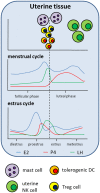Endocrine factors modulating immune responses in pregnancy
- PMID: 24847324
- PMCID: PMC4021116
- DOI: 10.3389/fimmu.2014.00196
Endocrine factors modulating immune responses in pregnancy
Abstract
How the semi-allogeneic fetus is tolerated by the maternal immune system remains a fascinating phenomenon. Despite extensive research activity in this field, the mechanisms underlying fetal tolerance are still not well understood. However, there are growing evidences that immune-immune interactions as well as immune-endocrine interactions build up a complex network of immune regulation that ensures fetal survival within the maternal uterus. In the present review, we aim to summarize emerging research data from our and other laboratories on immune modulating properties of pregnancy hormones with a special focus on progesterone, estradiol, and human chorionic gonadotropin. These pregnancy hormones are critically involved in the successful establishment, maintenance, and termination of pregnancy. They suppress detrimental maternal alloresponses while promoting tolerance pathways. This includes the reduction of the antigen-presenting capacity of dendritic cells (DCs), monocytes, and macrophages as well as the blockage of natural killer cells, T and B cells. Pregnancy hormones also support the proliferation of pregnancy supporting uterine killer cells, retain tolerogenic DCs, and efficiently induce regulatory T (Treg) cells. Furthermore, they are involved in the recruitment of mast cells and Treg cells into the fetal-maternal interface contributing to a local accumulation of pregnancy-protective cells. These findings highlight the importance of endocrine factors for the tolerance induction during pregnancy and encourage further research in the field.
Keywords: alpha-fetoprotein; estradiol; human chorionic gonadotropin; immune regulation; luteinizing hormone; pregnancy; progesterone.
Figures



References
Publication types
LinkOut - more resources
Full Text Sources
Other Literature Sources

